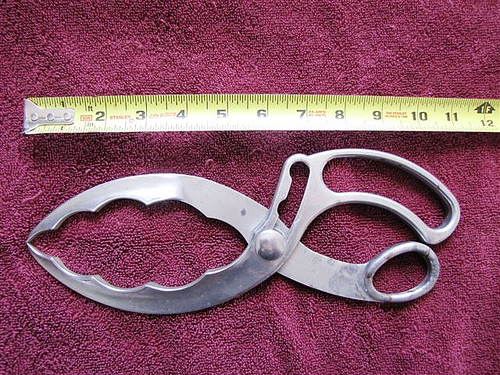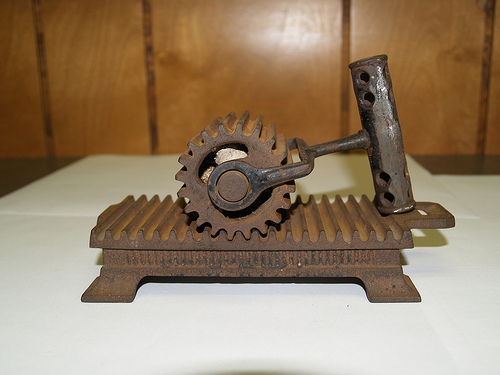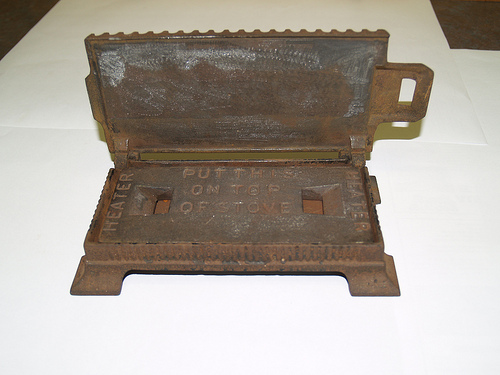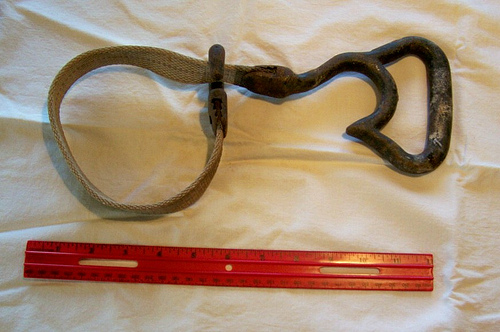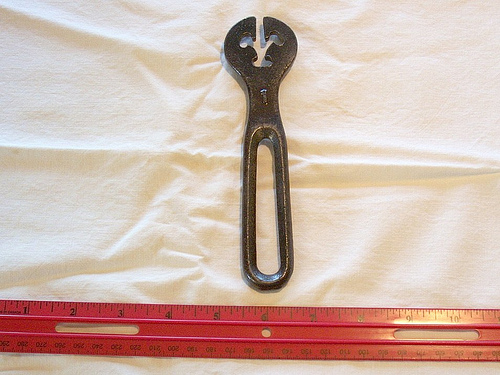Hello from Hazard!
Two more readers concurred that Item No. 880 was a jar wrench for tightening/opening jar lids. Dave Cover, of Cortland, Ohio, and Matilda Brenner, of Dalton, Ohio, added their two cents’ worth to the discussion.
Item No. 880
* * *
But we had no trouble identifying Item No. 881 as an ironing tool called a “fluter” or “pleater” last week, and the mailbag and e-mail in-box continued to overflow with that response.
As we mentioned last week, the flat plate or slug, was placed on the stove and heated, then inserted back into the standard (Dave Cover tells us that’s what the base is called). When you used the notched roller over the heated notched standard, you could iron pleats and frills and ruffles.
Item No. 881
Readers who kept the fun going with their correct answers included: Dave Cover and Matilda Brenner; Shirley Eagan, Morgantown, W.Va.; Gailey Henderson, Williamstown, W.Va.; David S. Brown; Jeff Baird, Thornville, Ohio; Betty Whitmer, Navarre, Ohio (who adds, “and, no, despite what my grandsons say, I’m not old enough to have used one!” of our tool that most say dates to the 1875-1880s); Joe Betz, Library, Pa.; Barbara Kovach, Hudson, Ohio; Gideon D. Troyer, Baltic, Ohio; Terp Musselman, Bexley, Ohio; Nello Mungai, Hickory, Pa.; and Ashley Biega, Pittsburgh, Pa., who also sent in some great background information:
“Known by a variety of names these antique irons are commonly referred to as pleaters, plaiters, crimpers, fluters, rufflers or ruffle irons. They were in their heyday during the mid to late 1800s and they are uniquely American.
“Some were still being made up into the 1920s for commercial applications and are usually very large and electric.
“These antique pressing iron came in several different styles — the machine crank, the rocker style, the roller style, tongs, and more. Perhaps the most innovative interesting and collectible versions of fluting irons are the combinations a single iron, which served a dual function of being a flat iron and/or a polishing/glossing iron when used in one position or another, and which then, by one means or another, converted into a fluting iron.
“The picture that you have is of the roller style fluter. The top piece is manually rolled rather than rocked over the bottom to press the fabric into the flutes. These usually fetch $40 to $50 on eBay.
“Unusual irons of this style would be those with unique handle designs or other odd features. There is one rare versions called the “Indicator” because it has a thermometer built into the fluting plate. Another unusual one that has a double roller on the handle.”
Thanks so much, Ashley, for this great information, including the current value.
* * *
And we also had some quick responses on Item No. 882, shared by Randy Winland, of Prospect, Ohio.
It’s a hose strap, or hose tool, used by firefighters to hold a fire hose on a ladder. The small hooked end goes around the hose and hooks on the strap. The large hooked end can be used to pull the hose and to hook on a ladder and help support the hose, giving the firefighter use of both hands to aim the hose. It also helps support the hose when going to higher stories.
Walt of Medina, Ohio, e-mailed us and said he used Item No. 882 when he worked the piers in a shipyard. He said the item brought back a lot of “stiff” and “sore” memories.
Butch Hemshrodt, of East Springfield, Ohio, Don Martin, of Republic, Ohio, Carl Kutsko of North Jackson, Ohio, Kyle Traczyk of St. Clairsville, Ohio, and George Vernon of Sebring, Ohio, were quick to tell us how it was used. Thanks, guys!
* * *
We’ll stick with another item submitted by Randy Winland for Item No. 883 (we’re on a roll, here!). The cast iron wrench is about 6 1/2 inches long and less than 2 inches across the rounded end. On the flat side, in the narrow part, is the number “1.” Winland says the three “teeth” look like they could be used to tighten something, but not loosen it, due to the their angle. The center is open in a three-leaf clover pattern.
Item No. 883
Do you know how it was used?
Write to: Hazard a Guess, P.O. Box 38, Salem, OH 44460; or via e-mail to: editorial@farmanddairy.com.






